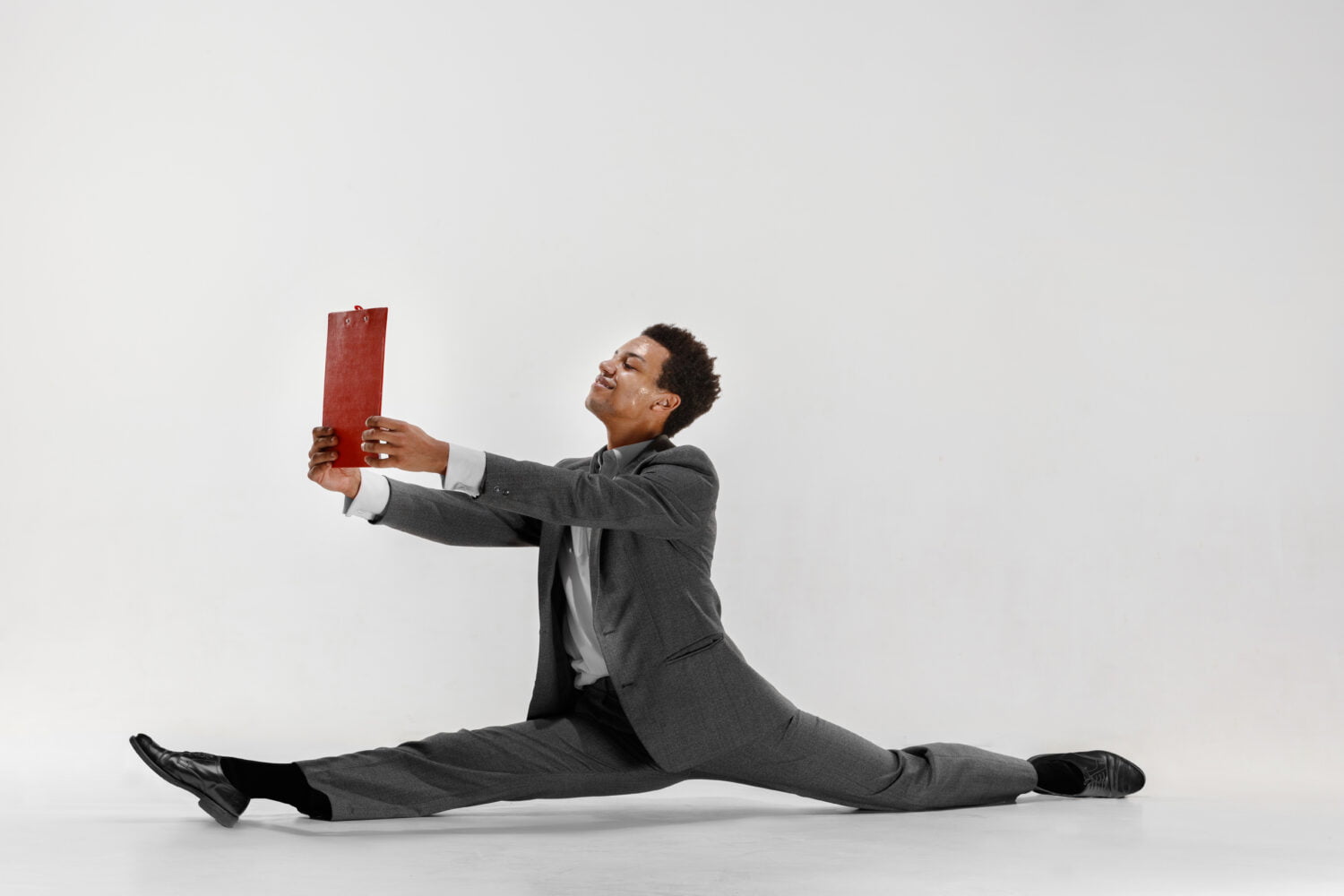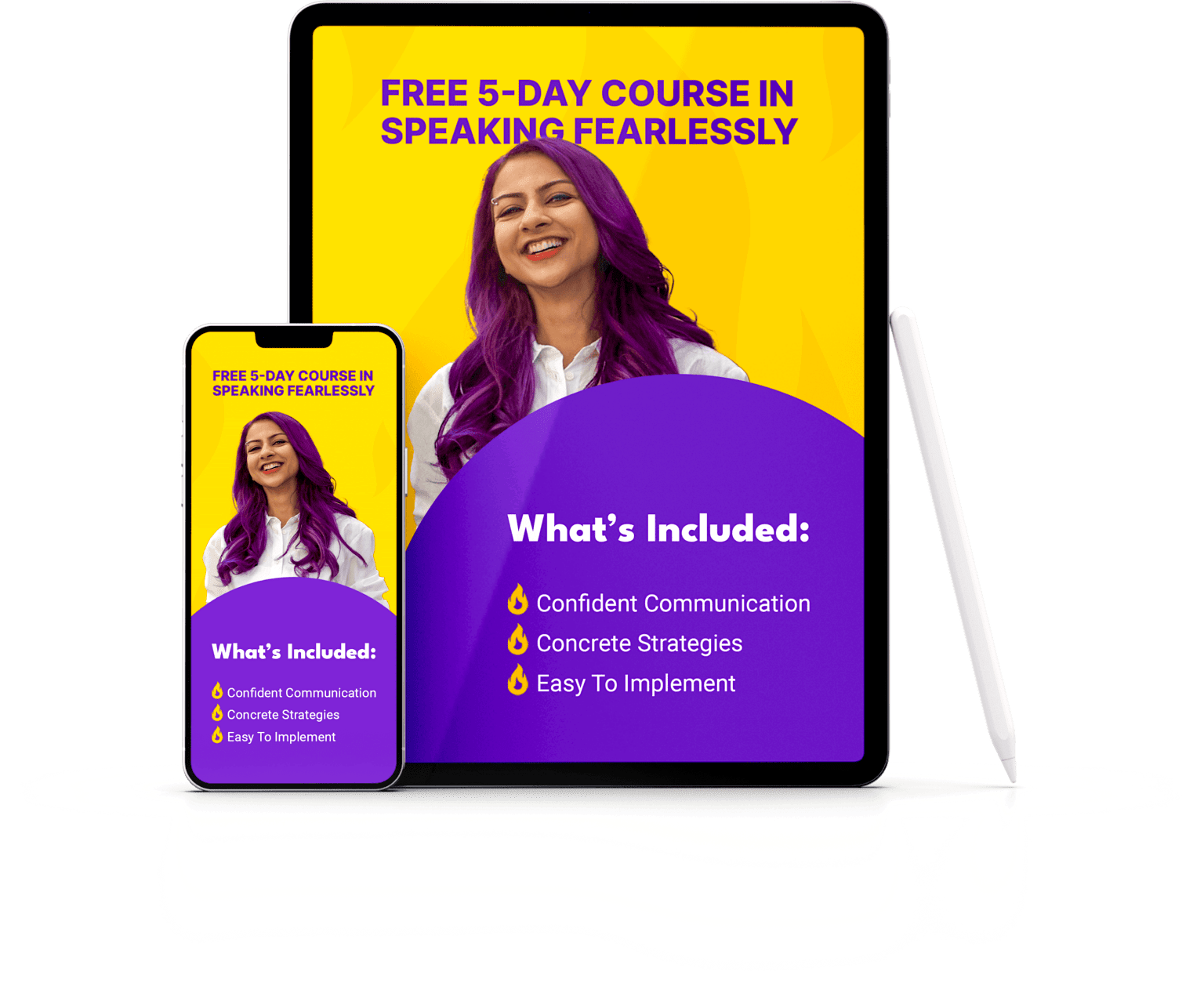When I started working with Claire, a newly promoted senior manager, she told me her presentations always started a bit rocky. She would feel nervous. Her heart would start beating faster. And she had no control over her pacing.
As we worked together, I taught her a warm-up routine to do before she presented to an audience. The goal was for her to have a smooth, confident, impactful start and make a memorable first impression instead of fumbling her intro.
Public speaking can be a nerve-wracking experience for many leaders. The mere thought of facing an audience can lead to feelings of anxiety and stage fright.
The truth is – you can be completely confident and comfortable from the get-go – without feeling the nerves at the outset.
A great way to tackle these nerves and create a confident and commanding presence on stage is to warm up before you deliver a presentation.

Image by master1305 on Freepik
Warming up before working out is a common practice to prepare the body and mind for optimal performance. Warming up before you speak is similar: it helps you overcome nerves, sound confident and engaging, and deliver your message effectively.
Here are some warm-up exercises you can do to set yourself up for success when you speak to an audience – on stage or in person.
Do you need help with improving your speaking skills? I’m here to help.
What’s inside this article
1. Deep Breathing
It may sound simple but creating a deep breathing routine has a huge impact on the success of your presentation. It improves your heart rate, lowers your blood pressure and activates your nervous system. If your breathing is stable:
- You talk at a regular pace instead of speaking too fast uncontrollably.
- You won’t ramble or use filler words out of nervousness.
- You’ll feel calm and in control.

Here are three techniques to try:
a) Simple deep breaths
Start by planting both feet on the floor. Now inhale through your nose, and exhale through your mouth. Try to hold your breath for a few seconds, then breathe out slowly. Do it a couple of times. You’ll feel your stress levels decreasing.
b) Diaphragmatic breathing
This is also known as belly breathing. You can do this by standing tall with your feet shoulder-width apart or sitting on a chair with your back straight. Make sure that your shoulders are relaxed and not tense. Place one of your hands on your abdomen, just below your rib cage. Inhale deeply through your nose.
As you inhale, focus on filling your belly with air. Feel your abdomen rise as the diaphragm expands downward. Then release the breath slowly and steadily through your mouth.
Check out this article for more breathing exercises that you can use for warming up.

c) Vocal Resonance breathing:
Vocal resonance is the quality of your voice that makes it sound warm, rich, and full. It’s a learned skill. Everyone is capable of having a resonant and confident sounding voice.
When you tone your vocal resonance, you are removing the tension from your voice and enhancing your vocal tone, range, and volume.
One of the ways you can tone your voice resonance is by using a straw. Try breathing in and out through the straw, forcing your breath to pass through the narrow opening. Doing this can help strengthen your vocal cords.
2. Vocal Warm-Ups
The tone of your voice plays a crucial role in captivating your audience and conveying your message effectively. It may sound trivial, but your tone can either attract or repel your audience. When you’re nervous, your voice might quiver or sound thin. Doing vocal warm-ups can enhance the richness and quality of your voice:
- They help loosen up your tongue, jaw, and vocal cords.
- They increase your flexibility and vocal range.
- They enable you to articulate better.
Here are five vocal warm-ups that are incredibly effective:
a) Tongue twisters:
These help warm up your tongue, mouth, and lips. Tongue twisters challenge your articulatory muscles. They require precise and rapid movements of these muscles, improving your diction and clarity.
Try these common tongue twisters to start:
- Round the rugged rocks, the ragged rascal ran.
- Silly Susan sells seashells by the seashore.
- James just jostled Jean gently.
b) Humming
Start with your lips gently closed with your jaw loose. Slowly breathe in and exhale while humming “hmmmmmm.” Repeat the process but now open up the “hmmm” into different vowel sounds one by one – “hmmmmmm…..aahhhhh”, “hmmmmmm….ooooooo” and so on.
Here is a video to demonstrate:
c) Yawning
It may sound funny, but yawning is a very useful technique to warm up before your speaking engagement.
When you yawn:
- You are letting the warm air in.
- You’re breathing deeply.
- And you’re opening your mouth wide, so your facial muscles are warming up.
Let out a big yawn for at least 15 seconds, and it can do wonders for your presentation.
d) Lip buzzing
Also known as lip trills, lip buzzing involves vibrating your lips together but not putting tension on the vocal cords.
You can do this by relaxing your lips and trilling them. Your lips should vibrate freely with the airflow. If there is too much air pressure, your lips won’t vibrate. If there is too little pressure, the sound will stop.
Doing this can help control your breath, improve pitch range and agility.

e) Jaw massage
This is a good warm-up to reduce the tension in the mouth and jaw area.
Place your palms on the sides of your face and gently massage the jaw and cheek muscles in slow circular motion. Keep massaging while you lower and raise your jaw.
Then say “mamamamama” but with a very light lip contact for the “m.” Then change it to “wawawawa” but this time, light lip round for a slightly distorted “w.”
3. Voice projection arm swings
This is a three-in-one exercise:
- It warms up your upper body.
- It opens up your chest.
- And it activates your vocal cords before speaking.
By incorporating this exercise into your warm-up routine, you can enhance your vocal projection and engage your audience with a confident and powerful voice.

Step 1:
Stand with your feet shoulder-width apart, making sure that you are maintaining a good posture. Keep your spine straight and shoulders relaxed. Take a deep breath, filling your lungs with air, then exhale slowly to release any tension in your body.
Step 2:
Now extend your arms straight in front of you, parallel to the ground. Your palms should be facing downwards. Start swinging your arms forward and backward in a controlled manner.
Step 3:
Gradually increase the speed and range of motion of your arm swings. As you do this, start projecting your voice outwards.
This movement helps open up your chest and activate your vocal cords to prepare your voice for projection during your speech. Continue swinging your arms for about 30 seconds to 1 minute, or until you feel a sense of warmth and energy flowing through your upper body.
4. Facial Warm-Ups
Facial exercises are important before you need to speak in public. They release the tension in your face, improve facial muscle mobility and enable you to relax.
Failing to warm up your face before your presentation may result in you not being very expressive. It’s hard to communicate enthusiasm and energy when your face shows no emotion.
Here are three ways you can release the tension from your face:
a) The blinking eye and mouth exercise:
Open up your mouth and eyes as wide as possible (like you have just seen a ghost). Next, squish your face up like it’s a piece of a raisin. Imagine biting the sourest lemon ever. Then stretch your face out again like the ghost reappeared in front of you. And then bite that imaginary lemon again to make your face wrinkled and small.
Doing this action several times can help relax the muscles in your face.
b) The smile and kiss exercise:
Smile as wide as possible. Stretch your mouth from side to side as far as you can.
Next, press your lips together in a big kiss. Do this a few times to relax the muscles around your cheeks and lips. It can help brighten your face and make you appear more animated and energetic.
c) Expression warm-ups
Take a line that you say often – for example, “My name is X and I do Y”. Now say it in different moods and styles. I like giving my clients the challenge of saying it in an enthusiastic tone, an angry tone and a humorous tone.
This helps prime your facial muscles to be expressive and also puts you in a more expressive frame of mind.
5. Physical Warm-Ups
Physical warm-ups get your blood circulation going before you start speaking. They help:
- Relieve the tension you’re holding.
- Relax your body (and mind).
- Then intentionally pump up your energy.
Here are three quick physical warm-ups for you to try:
a) Arm stretches
Start by standing tall and letting your arms rest by your sides, your palms facing forward.
Extend your right arm up toward the ceiling. Pinch your shoulder blades together and keep your right elbow straight.
You can stop once you feel a stretch on the front of your arm. Hold for 30 seconds and then switch sides and repeat the process.
b) Standing forward bend
You can do this exercise anywhere. Just stand with your feet together and raise your arms straight overhead.
Keep your back straight as you slowly hinge from your hips with your arms outstretched and reach down towards your shoes. Let your arms hang so you feel the weight release from your shoulders, upper back, and head.
c) Waist twists
The waist twist warm-up exercise helps loosen the abdominal and lower back regions. These areas can give you discomfort and pain when you are tense, making you feel agitated and anxious.
You can do this by placing your hands on your hips and rotating your waist in a semicircular motion. Keep doing it until you feel your muscles relaxing.

6. Mindful exercise: Count the sounds
Nope, we are not doing the preschool type of counting here. This is a mindfulness exercise to help you center yourself and gain hyper-focus and awareness.
Close your eyes and listen deeply to all the sounds that you hear around you.
Then count how many you can hear.
This warm-up helps you cope with anxiety, practice your listening skills, and most important of all, quieten your brain. With all the things running in your mind before your presentation, you need some time to calm down and just relax your brain.

7. Recall past successes
This practice will help you get into a confident state of mind. This warm-up does not need much physical movement.
You just need to close your eyes for 1-2 minutes and think about a time in your life when you felt the most confident or self-assured. The more you can feel the emotion from that moment, the more confident you will feel.
This may sound simple, but it can make a huge impact on your presentation.
Conclusion
I know I have listed a lot here, but you don’t need to do all of them before you speak in public. Pick some that work for you. You’ll only find out which ones are the most effective once you try a few from each category to see the impact they have on your mood and mental state.
If you need more personalized coaching on how to become a confident speaker – Let’s talk!



